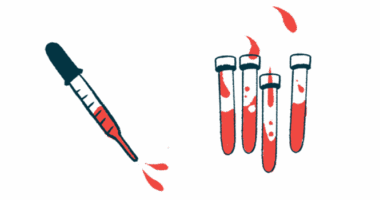Substrate reduction therapy for Gaucher disease
Last updated April 30, 2025, by Lindsey Shapiro, PhD

Substrate reduction therapy (SRT) is one of the two main strategies used to treat Gaucher disease, a rare genetic condition in which a fatty substance called glucocerebroside (Gb1) builds up to harmful levels inside certain cells.
In people with Gaucher, mutations in the GBA1 gene lead to missing or defective glucocerebrosidase (GCase), an enzyme that’s needed to break down Gb1 into smaller molecules that cells can use. This GCase deficiency causes Gb1 to accumulate in various organs and tissues, driving Gaucher disease symptoms such as enlarged liver and spleen, bone abnormalities, and blood-related issues.
Currently, enzyme replacement therapy (ERT) and SRT are the only two classes of therapies approved for Gaucher disease.
Both aim to reduce Gb1 buildup to ease symptoms and slow disease progression, but they work in different ways. ERT delivers a working version of GCase via regular infusions into the bloodstream. By contrast, SRT limits the production of Gb1 — much like turning off a faucet when the drain is clogged.
While ERT remains the first-line treatment for many people, SRT offers a convenient oral alternative for eligible adults with Gaucher disease type 1.
What is substrate reduction therapy?
SRT is a treatment approach used for conditions where substances harmfully accumulate in the body due to a missing or defective enzyme. It has been mainly explored for treating lysosomal storage disorders such as Gaucher disease.
Lysosomal storage disorders are caused by a deficiency in enzymes found in lysosomes — cell compartments that serve as the cell’s recycling centers. When one of these enzymes is deficient, the molecules it would normally degrade — which are known as the enzyme’s substrates — accumulate to toxic levels, causing damage.
Unlike ERT, which provides a working version of the faulty enzyme to help cells clear the toxic substrate, SRT aims to reduce how much of that substrate is produced in the first place, helping to prevent its accumulation even in the absence of a functional enzyme.
Put simply, ERT helps the body recycle more waste, while SRT helps it produce less waste to begin with.
SRT for Gaucher disease works by inhibiting an enzyme called glucosylceramide synthase, which is involved in the first step of producing most glycosphingolipids, including Gb1. This approach doesn’t completely stop Gb1 production, but it reduces levels enough for the residual GCase enzyme activity to keep up more effectively.
Substrate reduction therapy for Gaucher disease
Two SRTs are currently approved by the U.S. Food and Drug Administration (FDA) for certain adults with Gaucher disease type 1. These medications are more commonly used when ERT is not an option, but may also be considered as a first-line Gaucher disease treatment for some people.
While SRT is considered a small molecule therapy for Gaucher disease, approved molecules cannot reach the brain or spinal cord. This means they are not effective for managing the neurological symptoms of Gaucher disease — which are a hallmark of Gaucher types 2 and 3. Still, SRT may sometimes be used to address non-neurological symptoms in patients with type 3.
For eligible patients, SRT has been shown in clinical trials to be generally well tolerated, leading to long-term reductions or stabilization of Gaucher symptoms — even in people who switched from ERT.
While both SRT and ERT can offer similar long-term clinical benefits in Gaucher disease, the oral dosing of SRT is thought to be more convenient and less invasive than the infusions ERT requires.
Available substrate reduction therapies for Gaucher disease
SRTs currently available for treating adults with Gaucher disease type 1 are:
These two FDA-approved treatments for Gaucher are both available as oral capsules.
A newer oral SRT, called venglustat, is also being developed. Unlike approved SRTs, the experimental Gaucher disease medication is designed to reach the brain and spinal cord and may hold promise for addressing the neurological manifestations of the disease.
Developed by Sanofi, venglustat is being evaluated in a Phase 3 clinical trial (NCT05222906) in combination with ERT to treat both neurological and non-neurological complications of Gaucher disease type 3.
Zavesca
Zavesca, marketed by Johnson & Johnson, was the first SRT to gain approval in the U.S. for Gaucher disease. It is indicated for adults with mild-to-moderate type 1 disease for whom ERT is not an option. The treatment is taken as oral capsules, usually three times per day, and generic versions are also available.
Cerdelga
Approved more than a decade after Zavesca, Cerdelga is cleared in the U.S. as a long-term Gaucher disease type 1 treatment for adults who are CYP2D6 extensive, intermediate, or poor metabolizers, as determined by a blood test. CYP2D6 is the liver enzyme responsible for breaking down Cerdelga in the body.
Developed by Sanofi, Cerdelga is taken once or twice daily, depending on a person’s CYP2D6 status. It is the only oral Gaucher disease treatment that can be used as a first-line therapy.
Potential side effects or complications
As with any medication, there are potential side effects and risks associated with SRT. The exact side effects will vary depending on the specific product that’s used, but more common ones may include:
- gastrointestinal problems
- weight loss or anorexia
- headaches
- tremors
- muscle cramps
- dizziness
- weakness
- vision problems
- low platelet count
- dry mouth
- heaviness in the arms and legs
- memory loss
- unsteady walking
- abnormal sensations, such as burning, tingling, or numbness
- menstrual changes
- fatigue
- pain in the back, extremities, or upper abdomen.
More rarely, SRT may also cause serious complications. For instance, Zavesca’s prescribing information comes with a warning about symptoms of nerve damage. In turn, Cerdelga can affect heart rhythm, and people with certain risk factors or taking specific medications may not be able to use it or may require a lower dose.
When considering whether SRT is an appropriate Gaucher disease medication, patients should discuss potential side effects and other safety concerns with their healthcare team. They should also tell their prescribing doctor if they experience any unexpected side effects or reactions to their therapy.
Gaucher Disease News is strictly a news and information website about the disease. It does not provide medical advice, diagnosis, or treatment. This content is not intended to be a substitute for professional medical advice, diagnosis, or treatment. Always seek the advice of your physician or other qualified health provider with any questions you may have regarding a medical condition. Never disregard professional medical advice or delay in seeking it because of something you have read on this website.
Recent Posts



